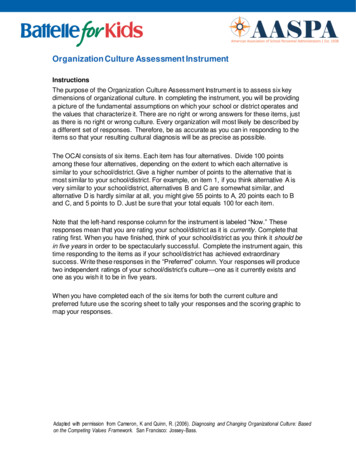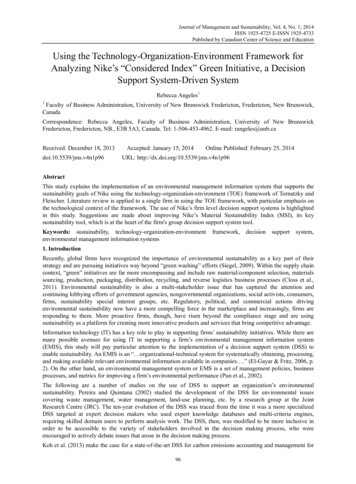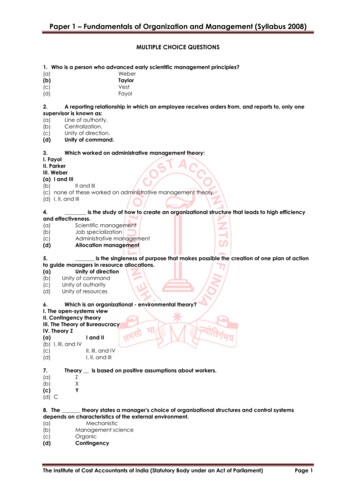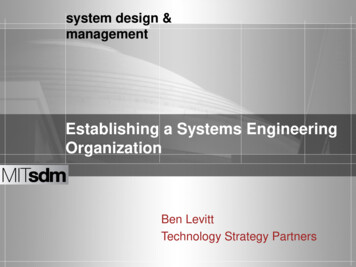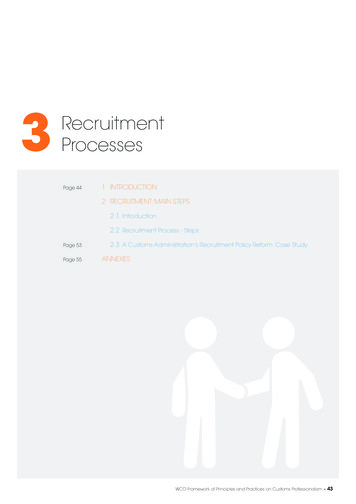
Transcription
TYPES OF ORGANIZATIONTYPES OF DEPARTMENTALIZATIONCENTRALIZATION AND DECENTRALIZATION“Organization is a system of co-operative activitiesof two or more persons.” Organization is theprocess of dividing up of the activities.Departmentalization is the process of breaking downan enterprise into various departments.CENTRALIZATION is the degree to which decisionmaking takes place at upper levels of theorganization.1) LINE ORGANIZATION : In this type oforganization, authority flows from top to bottomand responsibility flows from bottom to top.2) FUNCTIONAL ORGANIZATION : The main featureof functional organization is the division of workand specialization. In each department, there is oneexpert. An expert is not only a counselor butalso an administrator. He advices his subordinates.An Expert does not only bear responsibility of hisdepartment but also bear responsibility of alldepartments.(1) FUNCTIONAL DEPARTMENTALIZATION :Functional departmentalization defines departmentsby the functions like accounting or purchasing.(2) GEOGRAPHICAL DEPARTMENTALIZATION :Geographical departmentalization is an arrangementof departments according to geographic area orterritory.(3) PRODUCT DEPARTMENTALIZATION :Companies may have multiple products. . Allcommon activities required to produce and market aproduct are grouped together.(1) Environment is stable.(2) Lower-level managers are not as capable orexperienced.(3) Decisions are relatively minor.(4) Company is large.(5) Lower-level managers do not want a say indecisions.DECENTRALIZATION is the degree to which decisionmaking takes place at lower-level(1) Environment is complex, uncertain.(2) Lower-level managers are capable or experiencedat making decisions.(3) Decisions are significant.(5) Company is geographically dispersed.(6) Lower-level managers want a voice in decisions.3) LINE AND STAFF ORGANIZATION : Line and stafforganization is that in which the line heads areassisted by specialist staff. In each department,there is one expert and some line personnels / lineofficials. Line official will do all managerial work andexpert will give advice to line official or linepersonnel.(4) PROCESS DEPARTMENTALIZATION :Departmentalization is done on the basis ofprocessing.(5) CUSTOMER DEPARTMENTALIZATION :Customer divisions are divisions set up to serviceparticular types of clients or customersDictatorship is an example of centralized structureand democracy is an example of decentralization.SPAN OF CONTROLVERTICAL AND HORIZONTAL DIMENSIONSTALL AND FLAT STRUCTURE OF ORGANIZATIONSpan of Control states that how many employeescan a manager efficiently & effectively manage ? ORThe number of persons who are directly responsibleto the executive is called the span of control.The horizontal dimension defines the basicdepartmentation i.e. production, marketing etc.Departmentation is the process of diving anenterprise into different parts i.e. smaller, flexibleIf the span of control is narrow, then there will bemany management levels. That is, there will be manymanagers. This organization structure is called "TallOrganization Structure".The numbers of persons which can be effectivelysupervised by single executive is 6 to 8 in anaverage firm. However when activities are routinethen executive can supervise 20 to 30.If span is small, an executive may tend to oversupervise & may even do span leading to hissubordinates.If span is large, executive may not be able tosupervise his subordinates effectively & they maybecome careless or feel neglected.administrative units or sections.The Vertical dimension of the structure relate to thecreation of hierarchy of superiors and subordinates,leading to the establishment of a managerialstructure. It clearly defines that who will report towhom.Importance of Vertical and Horizontal Dimensions1. To establish “Superior-Subordinate” relationship2. To define chain of command3. To define span of control4. To establish flow of information5. To get advantage of specializationIf the span of control is wide, then there will befewer management levels. That is, there will befewer managers. This organization structure is called"Flat Organization Structure".In Tall Organisation Structure, a manager has tomanage only a few subordinates. Thus very good interms of Control, Close Supervision.In Flat Organisation Structure, a manager has tomanage many subordinates. Thus, there is loosecontrol and poor supervision.FORMALIZATIONMATRIX AND VIRTUAL ORGANIZATIONTYPES OF ORGANIZATIONAL STRUCTUREFormalization refers to how standardized anorganization’s jobs are and the extent to whichemployee behavior is guide by rules andprocedures.WORK SPECIALIZATIONMatrix organization is a hybrid structure. MatrixOrganization is a combination of two or moreorganization structures. For example, FunctionalOrganization and Project Organization. Theemployee has to work under two authorities(bosses).There are three main types of organizationalstructure: functional, divisional and matrix structure.It is also known as division of labor. An organizationis composed of man power of differentspecialization or skills. So there should be properdivision of work among different workers.CHAIN OF COMMANDIt is the line of authority extending from upperorganizational levels to lower levels, which clarifieswho reports to whom. Mangers need to consider itwhen organizing work because it helps employeeswith questions such as “Who do I report to?” and“ Who do I go to if I have a problem?”Prof. Chintan A. MahidaA Virtual org. is a network of firm held together bythe product. A Virtual Org. might not have even havea permanent office. A virtual organization consists agroup of companies, acting as one company to fulfilla need in the marketplace.Self-organizing systems are to put in simple manner –the system whose parts are separate, independent ofeach other, and then these parts acts in such a waythat they form connections with each other. Thus,this system is a system that emerges from“independent parts” to interdependent parts” of thesystem.1FUNCTIONAL STRUCTURE : Functional structure is setup so that each portion of the organization isgrouped according to its purpose. In this type oforganization, for example, there may be a marketingdepartment, a sales department and a productiondepartment.DIVISIONAL STRUCTURE : Divisional structuretypically is used in larger companies that operate in awide geographic area or that have separate smallerorganizations within the umbrella group to coverdifferent types of products or market areasMATRIX STRUCTURE : The third main type oforganizational structure, called the matrix structure,is a hybrid of divisional and functional o.cc
Unit - 3 : Organizational Structure and DesignQue : Define “Organization.” Explain types of organization.“Organization is a system of co-operative activities of twoor more persons.” Organization is essentially a matter ofrelationship of man to man, job to job and department todepartment. Organization is the process of dividing up ofthe activities which are necessary to any purpose andarranging them in groups which are assigned to individuals.Organization is necessary for attaining maximumefficiency with minimum of resources.F.W. Taylor suggested functional organization, because itwas difficult to find all-round persons qualified to work atmiddle management levels in the line organizations. In thistype of organizations specialists like production engineer,design engineer, maintenance engineer, purchase officer etc.are employed.There are three main types of organization structure.1) Line organization2) Functional organization3) Line and Staff organization.Each specialist is supposed to give his functional advice to allother foremen and workers. Each specialist is authorized togive orders to workers, but only in regard of his field ofspecialization.Functional OrganizationThe main feature of functional organization is the division ofwork and specialization. In each department, there is oneexpert. An expert is not only a counselor but also anIn this type of organization, the line of authority flows administrator. He advices his subordinates. An Expert doesdirectly from top to bottom and the line of responsibility not only bear responsibility of his department but alsoflows from bottom to top in opposite direction. Each bearresponsibilityofalldepartments.Fordepartmental head has complete control over his section example, Purchase Manager will take responsibility ofand he is fully authorized to select his labor, staff, purchasing items for all departments. HR Manager willpurchases of raw materials, stores and to set the standards take responsibility of recruitment of all departments.of output etc. The responsibility of each departmental headis clearly defined. Each department works as a selfAdvantagessupporting unit.1. Separation of work : In functional organization mentalAdvantageswork has been separated from routine work. Specialized and1. Simplicity : It is easy to establish and simple to skilled supervisory attention is given to workers. The result isunderstand. The entire activities are broadly grouped into increase in rate of production and improved quality of work.departments. Each departmental head having completecommand over his department.2. Ease of selection and training : Functional organization isbased upon expert knowledge. The availability of guidance2. Strong in discipline : Due to unity of command and through experts make is possible to train the workersunified control it is possible to maintain strict discipline. properly in comparatively sort span of time.The duties and responsibilities of each individual areclearly defined.3. It helps in mass production by standardization andspecialization.3. Unity of command : It establishes clear cut superiorsubordinate relationships. Each subordinate is responsibleDisadvantagesto only one superior. This develops a sense ofresponsibility and loyalty.1. Indiscipline : Since the workers receive instructions fromnumber of specialists it leads to confusion to whom theyDisadvantagesshould follow.1. Undue reliance : Loss of one or two capable men mayput the organization in difficulties.2. Shifting of Responsibility : It is difficult fro the topmanagement to locate responsibility for the satisfactory work.2. Personal limitations : In this type of organization an Everybody tries to shift responsibilities on others for theindividual executive cannot do justice to all different faults and failures.activities, because cannot be specialized in all trades.3. Increase in Cost : High salary is paid to the experts3. Overload of work : Departmental heads are overloaded employed. This increases the total cost of the job.with various routine jobs hence they can not spend time forimportant managerial functions like planning, development,budgeting etc.Line Organization(Oldest and Simplest Style)Prof. Chintan A. c
Line and Staff OrganizationLine OrganizationThe line and staff organization combines the lineorganization with staff departments that support andadvise line department. In each department, there is oneexpert and some line personnels / line officials. Lineofficial will do all managerial work and expert will giveadvice to line official or line personnel.Line and staff organization is that in which the line headsare assisted by specialist staff. The line maintains disciplineand stability, staff provides experts information and helpsto improve overall efficiency. Thus the staff are thinkerswhile the line are doers.Advantages1. Planned Specialization : The line and staff is a duplexorganization, dividing the whole work into creative planand action plan. The creative plan is concerned withoriginal thinking and the action plan takes care of theexecution of work.2. Availability of specialized knowledge : The staff withexpert knowledge provides opportunities to the line officersfor adopting rational multidimensional views towards aproblem. Therefore it helps to take sound decisions.3. Adaptability to progressive business. This type oforganization contains good features of both line as well asfunctional organization. Specialized staff can devoted theirtime for planning, method study research, collection of dataetc.,Functional Organization4. Less wastage & Improved Quality.Disadvantages1. Chances of Misinterpretation : Although the expert’sadvice is available, yet it reaches the workers through linesupervisors. The line officers may fail to understand themeaning of advice and there is always a risk ofmisunderstanding and misinterpretation.2. Expensive : The overhead cost of the product increasesbecause of high salaried specialized staff.3. Loss of initiative by line executives : If is they startdepending too much on staff may lose their initiative driveand ingenuity.Prof. Chintan A. c
Unit - 3 : Organizational Structure and DesignQue – Define ‘Departmentalization.’ List different types of departmentalization.Departmentalization is the process of breaking down anenterprise into various departments. How jobs aregrouped together is called departmentalization. ADepartment is an organization unit that is headed by amanager who is responsible for its activities.Departmentation and Division of labour are same things.However technically both are different. Both emphasizeon the use of the specialized knowledge, butdepratmentation has higher management level strategicconsiderations while the division of labour has a lowerlevel operating considerations.GEOGRAPHICAL DEPARTMENTALIZATIONFUNCTIONAL DEPARTMENTALIZATIONPRODUCT DEPARTMENTALIZATIONIt groups jobs according to geographic region.Geographical departmentalization is an arrangement ofdepartments according to geographic area or territory. It dividesworks well for international business. GeographicalDepartmentalization is beneficial when Organization are spreadover a wide a
There are three main types of organizational structure: functional, divisional and matrix structure. FUNCTIONAL STRUCTURE : Functional structure is set up so that each portion of the organization is grouped according to its purpose. In this type of organization, for example, there may be a marketingFile Size: 2MBPage Count: 10People also search fortypes of international organizations pdfadvantages of functional organizationexample of a functional organizationfunctional organization designfunctional organization project managementfunctional organization structure



